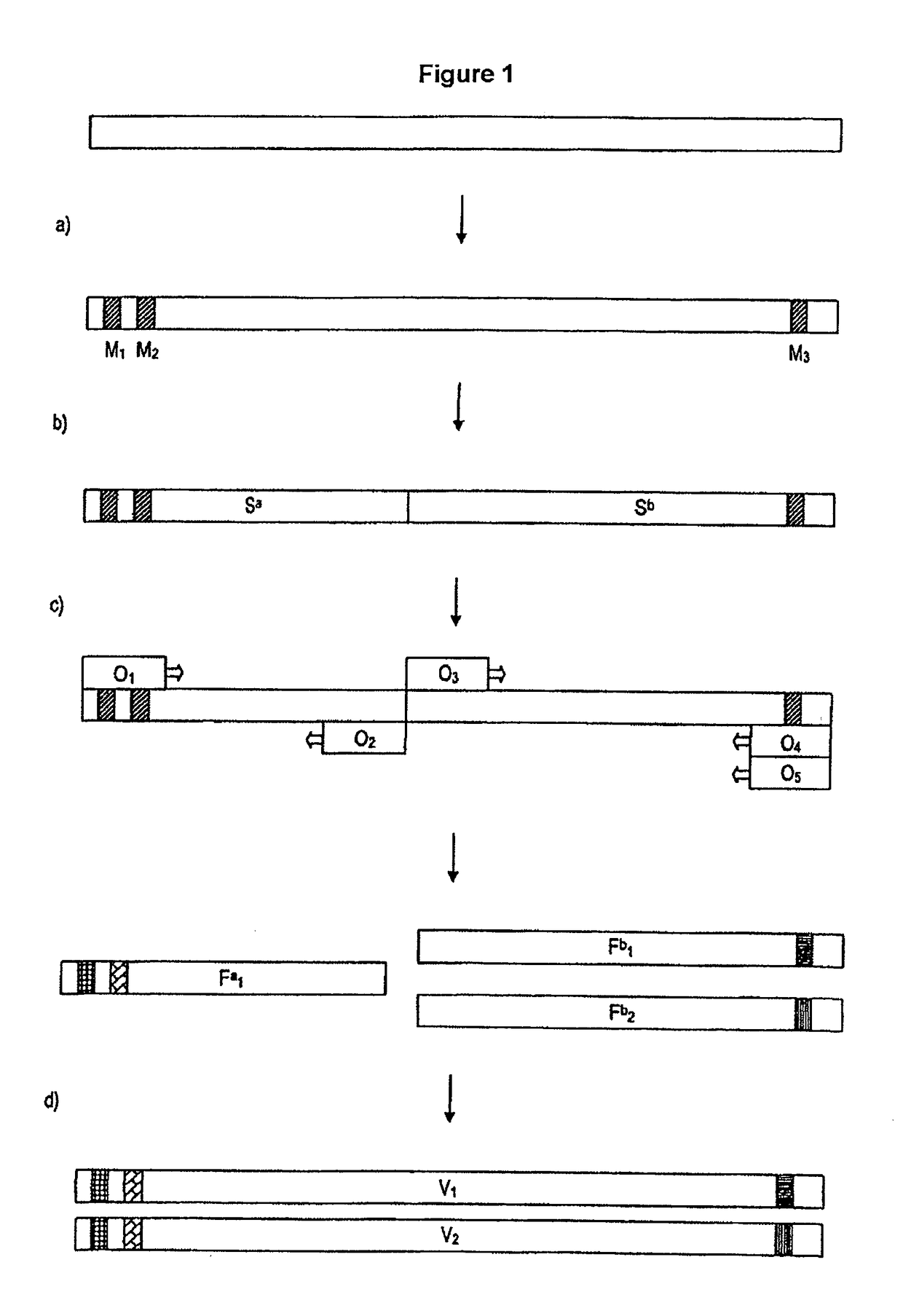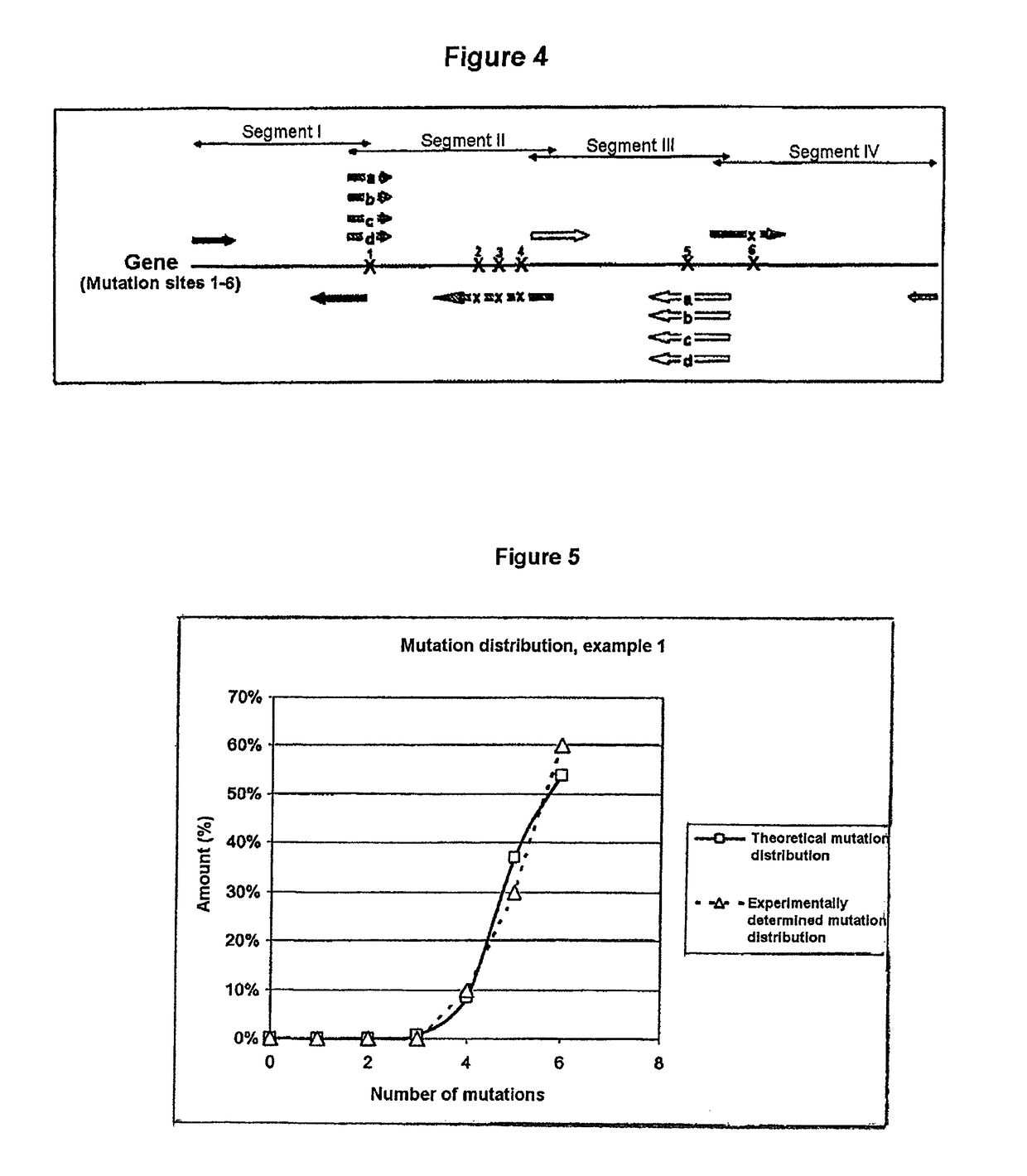Process for generating a variant library of DNA sequences
a technology of dna sequences and library structures, applied in the field of generating a variant library of dna sequences, can solve the problems of inability to control the number of oligonucleotides used per amplicon, inability to modify the properties of proteins through rational protein design, and inability to control the number of oligonucleotides used
- Summary
- Abstract
- Description
- Claims
- Application Information
AI Technical Summary
Benefits of technology
Problems solved by technology
Method used
Image
Examples
example 1
[0194]The creation of a variant library using the method according to the invention will now be described. The starting sequence is an enzyme gene. Within the gene sequence, 6 mutation sites (1-6) which lie on 3 sequence segments in total were selected. A fourth sequence segment does not contain any mutation sites.
[0195]
Sequence segmentSizeMutation siteI570 bp—II162 bp1-4III141 bp5IV251 bp6wtMutationaminositeacidAmino acids allowed1L4 (wt, K, R, M)2Y9 (wt, F, C, I, H, R, V, D, G)3W9 (wt, L, S, M, T, R, V, A, G)4N11 (wt, F, S, Y, C, I, T, V, A, D, G)5F4 (L, Q, V, E)6F6 (M, K, R, V, E, G)
[0196]This results in a theoretical complexity of the library of 85,536 different protein variants.
[0197]
Mutation siteMismatch primerMatch primer1312-4972* 15406 6*0*Here, use was made of primer mixtures which were generated by the use of nucleotide mixtures in the oligonucleotide synthesis (degenerate primers)
PCR Amplification of the Fragments:
[0198]The sequence segments I to IV were amplified separa...
example 2
[0215]In this example, the creation of an enzyme variant library using the method according to the invention is described. The starting sequence is the gene for lipase B from Candida antarctica (CalB). Within the gene sequence, 5 amino acids to be mutated (K32, Q58, R242, R249, E269) which lie on 5 sequence segments in total were selected.
[0216]
Sequence segmentSizeMutation site (amino acid)I167 bpK32II 99 bpQ58III570 bpR242IV 78 bpR249V396 bpE269wt amino acidAmino acids allowedK3211 (wt, P, L, F, W, S, Y, E, Q, G, A)Q5811 (wt, P, L, F, W, S, Y, E, R, G, A)R24211 (wt, P, L, F, W, S, Y, E, Q, G, A)R24911 (wt, P, L, F, W, S, Y, E, Q, G, A)E26911 (wt, P, L, F, W, S, Y, R, Q, G, A)
This results in a theoretical complexity of the library of 161,051 different protein variants.
PCR Amplification of the Fragments:
[0217]The sequence segments I to V were amplified separately by PCR. As the case may be, mutations were specifically inserted into the respective mutation sites via mismatch primers. ...
PUM
| Property | Measurement | Unit |
|---|---|---|
| structure | aaaaa | aaaaa |
| structure-activity relationships | aaaaa | aaaaa |
| stability | aaaaa | aaaaa |
Abstract
Description
Claims
Application Information
 Login to View More
Login to View More - R&D
- Intellectual Property
- Life Sciences
- Materials
- Tech Scout
- Unparalleled Data Quality
- Higher Quality Content
- 60% Fewer Hallucinations
Browse by: Latest US Patents, China's latest patents, Technical Efficacy Thesaurus, Application Domain, Technology Topic, Popular Technical Reports.
© 2025 PatSnap. All rights reserved.Legal|Privacy policy|Modern Slavery Act Transparency Statement|Sitemap|About US| Contact US: help@patsnap.com



